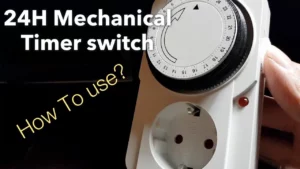Photocells and motion sensors are electronic devices that can be used to manage indoor or outdoor lighting. These sensors improve the safety and security of your home, turning on the lights automatically when it’s dark, or they detect movement. When extra light is unnecessary, they will also be automatically turned off to save energy. Get an understanding of the difference between photocells and motion sensors in addition to dimmers and other controls that can improve your home lighting.
1. The Science of Photovoltaics
There are several types of photovoltaic cells available, but they all use the same basic technology, namely semiconductors, to control current. Under normal circumstances, semiconductors do not conduct electricity, but when they are exposed to enough light, current starts to flow. You can adjust the level of light that activates the semiconductor in some products through the photocell function.
2. Photocell function: from dusk to dawn
One of the most common uses of photocells is to turn on external lights at sunset and turn off external lights at dawn. Because they can perceive the surrounding light levels, photovoltaic cells can automatically adjust to seasonal changes in the day and night cycle, regardless of the influence of daylight saving time. When you are not at home, the photoelectric cell that controls the external lights and the timer that turns on the internal device will create an illusion of occupancy, which can deter intruders. Other uses of photocells include turning on parking lots or street lights after dark, adjusting indoor dimmers to compensate for changes in natural light levels, or turning on or off illuminated commercial signs.
3. Type of photovoltaic cell
There are various photocells available today.
- The plug-in photocell works with a standard wall socket and a straight-through plug for control. They are a convenient way to turn on or off a single table lamp or floor lamp.
- Screw the phototube of the lamp or candlestick base into the bulb socket, almost any lamp or permanent fixture can be turned into an automatic lighting system. You need to install one of these devices on each socket to work properly.
- Line voltage, wired photovoltaic cells control the entire circuit, which is an ideal way to manage safety or landscape lighting.
4. Motion sensor in action
The main difference between a photocell and a motion sensor is that the former can detect changing light levels, while the latter can react to physical movements. There are two types of motion detectors. The active model emits light, radio or ultrasound. The movement of the detection area changes the reflected signal and activates the sensor. Some of these devices can even sense movement in corners. Passive motion sensors detect infrared energy emitted by warm objects such as animals or people. When these warm spots move, it triggers the sensor and any connected circuits.
For increased coverage and to eliminate false positives, motion sensors often use multiple detection methods.Equipment designed for outdoor use usually includes a photovoltaic function, which can shut down the system during the day to save energy. You can adjust the length of time that additional lights remain on after detecting motion using a timer built into some sensors.
5. The function of the detector
When the motion sensor detects motion in the coverage area, it usually turns on the outdoor lights. They are also used as energy-efficient occupancy sensors in commercial buildings, turning off lights in empty offices. Many of these products have adjustable sensing areas that allow you to cover specific locations, such as driveways or sidewalks, without being affected by the movement of tree branches or nearby streets.
6. Motion sensor varieties
Outdoor lighting controllers usually use motion sensors directly connected to a 120-volt circuit to control multiple fixtures.Security system sensors are usually battery-powered and send alarms to the base station wirelessly. Some independent motion sensors have built-in lights, making them easy to install and use almost anywhere.
7. Good ideas for lighting applications
The difference between photocells and motion sensors provides many control options for indoor and outdoor lighting systems.
- Use a combined photocell and motion sensor to activate the security lights around your home, but only after dark.
- Place a motion sensor and outdoor light on the sidewalk or garden path to ensure a safe standing when walking the dog or taking out the trash at night.
- Use photocells to ensure that the decorative lamps are always on after dark.
- Combine a lamp, a plug-in photocell and a traditional light switch together to create an automatic light that can only be turned on when needed.
- Use motion sensors and integrated lights to provide hands-free staircase lighting.
The motion sensor and photocell switch the power supply according to the changing light level or the detected motion. They are compatible with many different types of lamps and some are compatible with safety systems. Through these flexible controls, you can save energy and enhance the appearance and safety of your home.









